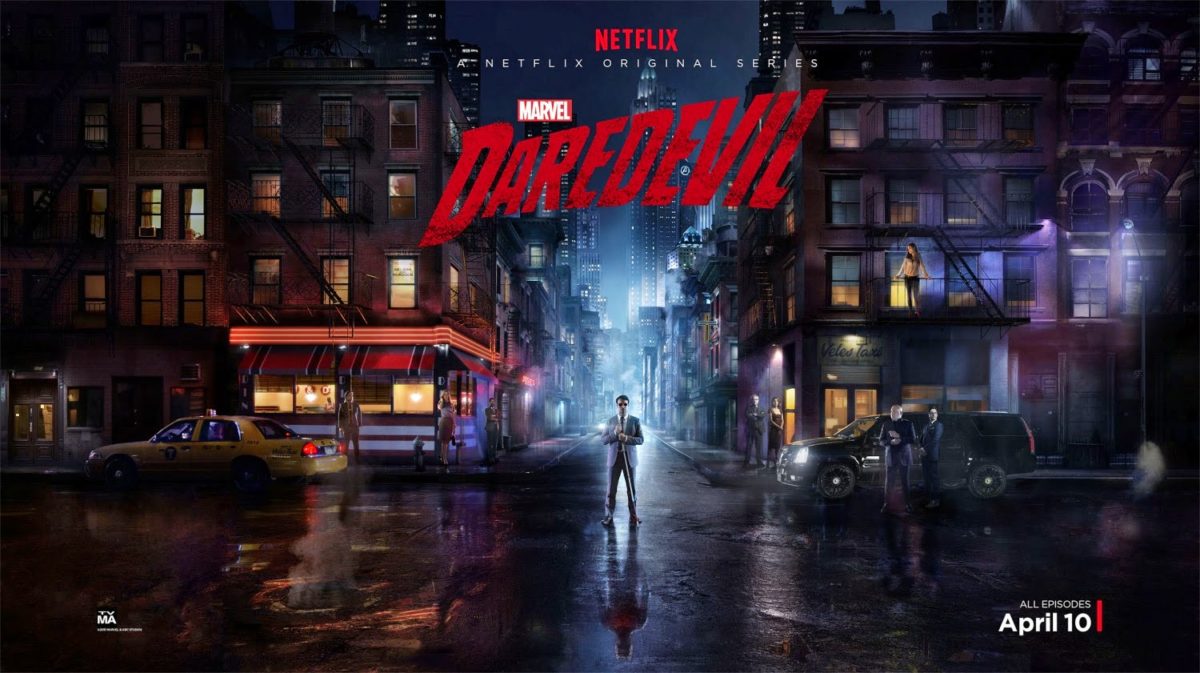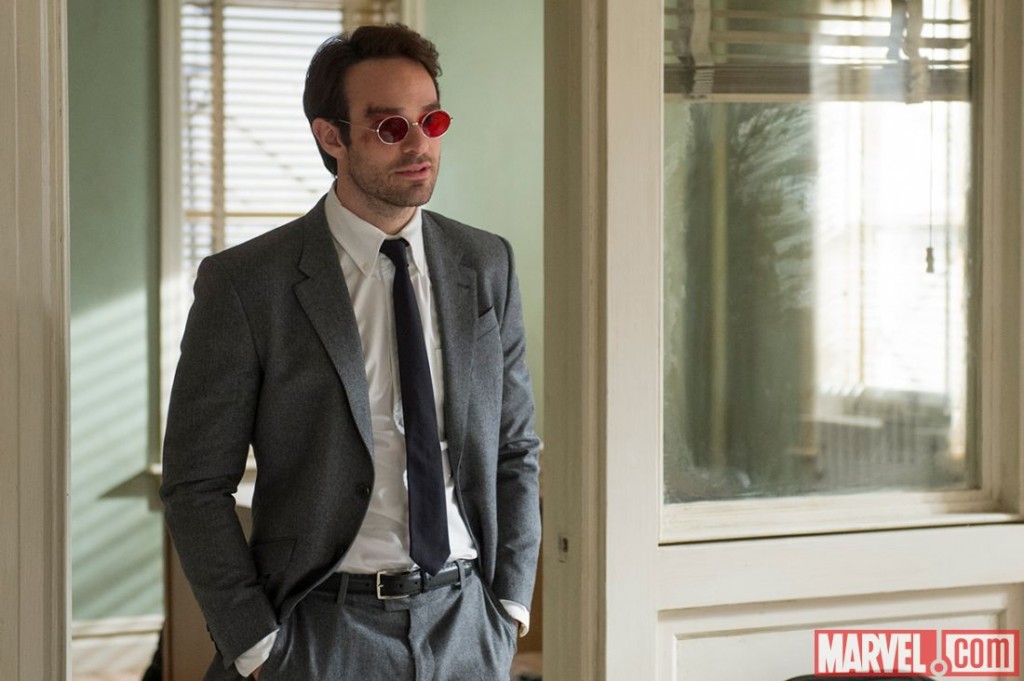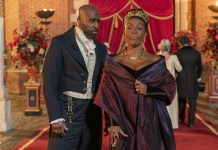Chances are that many people have spent as much of the day as possible watching Marvel’s new Netflix series Daredevil, the entirety of which has just been made available online. Perhaps some will even continue to watch until they have seen the whole series, start to finish. Speaking for myself, though, I’m old fashioned; I can only manage six hours’ worth of television at a time, and as such, this will be a review of the first half of the series. From what I’ve seen so far, though, I’m very impressed with Daredevil.
The blind lawyer-by-day/costumed-vigilante-by-night Matt Murdock was created by writer Stan Lee and illustrator Bill Everett, and first appeared on the pages of Marvel comics in 1964. As one of the Marvel roster’s most grounded heroes (dealing with street crime, hoodlums and costumed ne’er-do-wells, whilst mostly leaving alien invaders and genocidal robots to other superheroes), it is perhaps fair to say that Daredevil is Marvel’s answer to the ever-so-slightly better known DC superhero Batman, and the two share something of a parallel history to strengthen this comparison. Both, for example, could be argued have a common ancestor in the pulp magazine vigilante the Black Bat, and both were reinvigorated in the 1980s by comic book writer and illustrator Frank Miller who, with his work on Daredevil as well as acclaimed Batman miniseries The Dark Knight Returns, was one of the figures who helped usher in a grittier, harder edged era for comic book superheroes.
It is definitely this darker, grittier Daredevil from which the new Netflix series takes its cues. Indeed, if anyone were going into this off the back of The Avengers (2012) or Guardians of the Galaxy (2014) expecting the same light-hearted banter that has come to be associated with the Marvel brand, I would strongly caution you: the BBFC have deemed this series worthy of a 15 certificate, and it more than earns it (not a criticism; just a word of warning).
More than fairly well any other mainstream superhero television show or film (exceptions being films like Watchmen (2009), Kick-Ass (2010) and Super (2010)), Daredevil truly depicts the immense, physical toll that getting into violent, bare-knuckle street fights can take on the participants in all its wet, crunchy, gruesome detail (the entirety of episode 2 revolves around Daredevil having to track down a human trafficking ring whilst suffering from severe knife wounds). It is also a programme that – Sopranos-like – absolutely does not hold back in depicting how brutally violent a life of crime is. In short, it is a programme that shows the consequences of the battles being fought on-screen.
Meanwhile – to continue with the Batman comparisons – the overall aesthetic of the series, from the dirty look everything has, to the choreographing and shooting of fights in quick cuts, to interrogation scenes, all seem to owe a lot to Christopher Nolan‘s Dark Knight Trilogy, most especially the first entry Batman Begins (2005).
Another comparison to Begins that could be made is the way in which the first two episodes intercut between the action taking place in the present, and the formative, defining experiences of Matt Murdock in flashback. All of this is a great asset to the show, giving it the same (if not greater) verisimilitude as the Nolan Batman films, and allowing us the audience to gradually come to know Matt Murdock better as a character in a well paced manner over the course of the episodes.
What’s more – as far as pacing is concerned – the series is also clever in that it does not attempt to force the concepts of Daredevil’s heightened senses on the audience too early in the series, eschewing computer generated depictions of how his radar sense “sees” (until episode 6, at least) in favour of subtly conveying them through slightly increasing the volume of whatever it is Murdock may be hearing.
As for how Daredevil ties in with the rest of the Marvel universe; the New York of Daredevil is one that is still in the process of rebuilding in the wake of the Chitauri invasion of The Avengers, and in this fragile state, crime and corruption have taken root; infiltrating the police force and forming a major part of the reconstruction of the city. This is how, in the first episode, we are introduced to the protagonists, as Nelson and Murdock secretary-to-be Karen Page (Deborah Ann Woll) being framed for a murder in order to discredit her, following her discovery of illicit dealings on the part of her current employers. It is up to her future employers Matt Murdock (Charlie Cox) and Franklin ‘Foggy’ Nelson (Elden Henson) to acquit her, and the former to discover who the mysterious powers are that want Karen dead; an investigation that alerts the wet-behind-the-ears crime fighter to the existence of the vast criminal conspiracy he is pitting himself against.
The cast for the series is a good one. Charlie Cox gives a subdued, but compelling and likeable performance as Matt Murdock. From the first scene in which the audience is introduced to the character in a confessional, Cox does a fine job of illustrating a quiet, conflicted nature about what he intends to do.
Meanwhile Deborah Ann Woll gives a brilliantly convincing terrified introductory performance, but also illustrates the character’s headstrong nature well, and is able to spark off Eden Henson in their exchanges as Karen and Foggy, lending their banter a genuine charm.
Another strong character is Rosario Dawson as Claire Temple; the nurse who treats Murdock for his knife wounds in episode 2, and becomes his ally and seemingly (in a break from comic book lore) romantic interest in the process.
Rounding off the A Cast is Vincent D’Onofrio as Wilson Fisk. Fisk is the man behind all of the illegal activity in Hell’s Kitchen; the head and unifying force for a myriad of potentially competing criminal subgroups; the ‘Kingpin’, if you will, and what D’Onofrio brings to the table is something that many have said, for all its many strengths, the Marvel Cinematic Universe is sorely lacking in: a good, strong, multi-layered villain.
Fisk is, without a doubt, a brutal, vicious and completely ruthless criminal (and nowhere is this more clear than the truly horrifying conclusion to episode 4), but rather than being simply a cardboard cut-out enemy, we are also privy to his gentler, more vulnerable side. He is a renaissance man, who (at least professes) feels great guilt at the violent deeds he commits. Indeed, the ultimate irony is that the audience’s introduction to this most-powerful and intimidating of men in person is to witness him becoming flustered in an attempt to invite a woman out to dinner.
Opinions on the first six episodes of Daredevil, then, are that it is a supremely well executed and well written crime drama, that pulls no punches in its depiction of truly horrendous and frighteningly realistic violence, which so far has set up a single, strong ongoing story arc for the hero to travel.
Lacking the camp factor that has made shows like Gotham (which I still think is good, notwithstanding) divisive, Daredevil goes straight for the jugular, and – in this instance – is all the more effective for it.
Our review of the second half of Series 1 of Daredevil will be posted tomorrow.































[…] posted on filmandtvnow.com […]
Comments are closed.